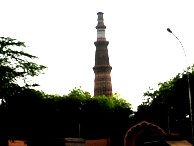|
           
|
|
QUTUB COMPLEX
( NEW DELHI ) INDIA
The Qutb complex is an array of monuments and buildings at Mehrauli in
Delhi, India, the most famous of which is the Qutub Minar. This complex
was first constructed by Qutb-ud-din Aybak, the first ruler of the Slave
Dynasty, and his successor Iltutmish (aka Altmash) in his new city
called the Qila-Rai-Pithora near Prithivraj Chauhan's older city. The
complex was added to by many subsequent rulers, including Iltutmish and
Ala ud din Khilji as well as the British.
QUTUB MINAR
Qutub Minar (Urdu: قطب منار) is the tallest brick minaret in the world,
and an important example of Indo-Islamic Architecture. The tower is in
the Qutb complex in South Delhi, India. The Qutb Minar and its monuments
are listed as a UNESCO World Heritage Site.The Qutub Minar is 72.5
metres high (237.8 ft) and requires 399 steps to get to the top, The
diameter of the base is 14.3 metres wide while the top floor measures
2.75 metres in diameter. (As a comparison, the 111m Saturn V rockets
used during the Apollo moon landings stood one-and-a-half times taller).
A second tower ( Alai Minar , Qutub Complex ) was in construction and
planned to be taller than the Qutub Minar itself. Its construction ended
when it was about forty feet tall.
Quwaat Ul Islaam Mosque
Allauddin’s Madarsa
Ala-ud-din Khilji (Persian: علاء الدین خلجی ) (real name Juna Khan) (d.
1316), was the second Indian ruler of the pashtun Khilji dynasty. He
reigned from 1296–1316. Alauddin died in January 1316, of edema. It is
believed that his lieutenant Malik Naib hastened his death.
Alai Minar ( 1311 A.D )
This Unfinished Minar is named after Allauddin Khilji ( 1296-1316 A.D) ,
who had doubled the Size of Quwaat Ul Islaam Masjid and had started the
construction of another Minar , twice the size of Qutub Minar , so as to
be proportionate with the enlarged Mosque , but because of his death ,
construction of the Tower could not be completed . The extent Height of
the Tower is supposed to be 24.5 Metres. It is evident that the Archtect
intended to face the Present rubble Masonary Core with dressed Stone or
Some Other Better Material .
Amir Khusru in his Tariq - I - Alai mentions about the intentions of
Allauddin Khilji to increase the area of the Mosque and construction of
another Minar .
Iltutmish Tomb
Shams-ud-din Iltutmish, or Altamash, (Persian: شمس الدین التتمش ) was
the third Sultan of Delhi and the third ruler of the Slave dynasty (d.
1236).
Shams-ud-din belonged to the tribe of Ilbari in Turkestan. He was
remarkably handsome in appearance and showed signs of intelligence and
sagacity from his early days, which excited the jealousy of his
brothers, who managed to deprive him of his paternal home and care. But
adversities did not mar his qualities, which soon opened a career for
him. His accomplishments attracted the notice of Qutub-ud-din-Aybak then
Viceroy of Delhi, who purchased him at a high price. By dint of his
merits, Shams-ud-din raised his status step by step until he was made
Governor of Badaun and was married to a daughter of Qutub-ud-din. In
recognition of his services during the campaign of Muhammad of Ghur
against the Khokhars, he was, by the Sultan's order, manumitted and
elevated as Amir-ul-Umara.
Iltutmish was gifted with brilliant qualities as a man and extended his
patronage to arts and letters. The completion of the structure of the
famous Qutub Minar which was built from the ruins and parts of destroyed
Hindu temples at Delhi by the Sultan in A.D. 1231-1232 stands as an
imperishable testimony to his greatness.
In A.D. 1236 Iltutmish, on his death-bed, nominated his daughter Raziya
as his heiress. But the nobles of the court were too proud to bow their
heads before a woman, and disregarding the deceased Sultan's wishes,
raised to the throne his eldest surviving son, Rukn-ud-din Firuz. The
death of Iltutmish was followed by years of political instability at
Delhi. During this period, four descendents of Iltutmish were put on the
throne and murdered.
|
 |